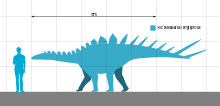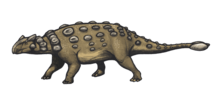Alcovasaurus
Alcovasaurus is a genus of herbivorous thyreophoran dinosaur that lived in the Late Jurassic. It was found in the Morrison Formation of Natrona County, Wyoming, United States.[1] The type species is Stegosaurus longispinus, and the combinatio nova is Alcovasaurus longispinus.
| Alcovasaurus | |
|---|---|
 | |
| Skeletal reconstruction of Alcovasaurus longispinus, with known material in white | |
| Scientific classification | |
| Kingdom: | Animalia |
| Phylum: | Chordata |
| Clade: | Dinosauria |
| Order: | †Ornithischia |
| Suborder: | †Stegosauria |
| Family: | †Stegosauridae |
| Subfamily: | †Dacentrurinae |
| Genus: | †Alcovasaurus Galton & Carpenter 2016 |
| Species: | †A. longispinus |
| Binomial name | |
| †Alcovasaurus longispinus (Gilmore 1914) | |
| Synonyms | |
| |
Discovery and naming
In July 1908, Professors William Harlow Reed and A.C. Dart of the University of Wyoming, in the Alcova Quarry in Natrona County, Wyoming, uncovered the skeleton of a stegosaurian. This would be the last major excavation of a dinosaur in which Reed was personally involved. In 1914, the find was named and described as Stegosaurus longispinus by Charles Whitney Gilmore on the basis of holotype UW 20503 (originally UW D54), a partial postcranial skeleton of an adult individual consisting of forty-two vertebrae, a fragmentary sacrum, two ischia, a portion of one pubis, the right femur, several ribs and four dermal tail spines. The specific name is derived from Latin longus, "long", and spina, "spine", in reference to the long tail spines.[2] Due to the presence of very long tail spines, S. longispinus was treated as valid by subsequent authors.[3][4][5] In 1993, S. longispinus was by George Olshevsky and Tracy Lee Ford seen as a possible North American species of the African genus Kentrosaurus as a ?Kentrosaurus longispinus.[6]
Unfortunately, the type specimen of this species was damaged in the late 1920s when the water pipes of the University of Wyoming's museum burst.[7] For this reason, the whereabouts of the type specimen were mistakenly considered to be lost,[8] although a femur catalogued as part of UW 20503 is still extant, as the last-surviving part of the type specimen.[9][10] Plaster casts had been made of the rear tail spikes. Also photographic evidence of the skeleton being excavated is still available, showing the bones in situ, as well as of the skeletal museum mount.[1]
Although the validity of Stegosaurus longispinus was disputed because the long dermal spines were likely to be a product of ontogeny or sexual dimorphism,[8] the amateur freelance paleontologist Roman Ulansky decided that the long tail spines were sufficient to remove S. longispinus from Stegosaurus and place it in a new genus, "Natronasaurus". Ulansky interpreted "Natronasaurus" as a close relative of Kentrosaurus in accordance with the hypothesis of Olshevsky and Ford (1993).[11] Ulansky published the name in a self-published electronic publication that was not archived by an independent organization nor had an ISSN. This renders the name "Natronasaurus" invalid, and Peter Malcolm Galton and Kenneth Carpenter gave the genus another name, Alcovasaurus, in 2016, as part of a revision of the species. The new genus name is a reference to Alcova, Wyoming. Galton and Carpenter also referred a very large round spike base to the species, found by Cliff Miles in Wyoming in the 1990s. Its present location is unknown but a cast was made with inventory number DMNH 33431.[1]
In 2019 it was by Francisco Costa and Octávio Mateus recombined into the genus Miragaia, as a M. longispinus.[12]
Description

Gilmore diagnosed S. longispinus from other Stegosaurus species by the presence of very long dermal spikes, distal caudal vertebral centra rounded in anterior/posterior view, vestigial transverse processes on distal caudal vertebrae, and centra with mushroom-shaped dorsal extensions.[2]
In 2016, Galton and Carpenter indicated five autapomorphies, unique derived traits. There are side processes being present in the distal, rear, tail vertebrae. The distal tail vertebrae are short, taller than long. There are two tail spike pairs that are very slender and elongated, with 90% of the thighbone length. The last spike pair has their greatest width at a quarter of the shaft length, measured from below. The lower joint surface of the condyles of the thighbone is limited to the underside.[1]
As a further possible autapomorphy, Alcovasaurus is different from the Jurassic North American stegosaurians Stegosaurus stenops, Stegosaurus sulcatus and Hesperosaurus in that its sacrum is connected to the ilia by six pairs of sacral ribs instead of four. Other stegosaurians show at most five. Gilmore also claimed that Alcovasaurus was distinctive in having a rear spike pair equaling the front pair in size. Galton & Carpenter found this trait difficult to confirm from the extant photographic evidence, but it would make Alcovasaurus differ from all known stegosaurians with four spikes, which always show a shorter rear pair. Also the two pairs would be positioned exceptionally far apart from each other.[1]
The thighbone length was by Gilmore determined at 1082 millimetres. The longest spike was eighty-six centimetres long. Its point was broken and Gilmore estimated the original length of the bone core at 985 millimetres.[2]
Galton and Carpenter saw the spikes primarily as weapons. They interpreted the side processes of the caudal vertebrae continuing to the very tail end as a support for an increased muscle mass to swing the tail. This might also be connected to the shortening of the caudal vertebrae, resulting in a tail that was about a quarter shorter than in Stegosaurus. A shorter tail could counteract the torsion caused by the greater moment arm of the very long spikes.[1] However, the 2019 re-interpretation of A. longicpinus as a member of the clade Dacentrurinae also prompted a re-interpretation of the tail anatomy. Rather than having a strongly muscled tail tip, A. longispinus more likely had very small tail vertebrae past the first third of the tail. Like other dacentrurines, the tail tip probably lacked strong muscles or indeed much soft tissue at all, creating a very flexible, whip-like tail that could be propelled by the heavily muscled tail base.[12]
Classification
Galton and Carpenter considered Alcovasaurus a member of the Stegosauridae, not more closely related to Kentrosaurus than to Stegosaurus.[1] However, a 2017 phylogeny of stegosaurids by Thomas Raven and Susannah Maidment found that Alcovasaurus lacked the fusion between the trochanters of the femur seen in adult eurypodans (stegosaurians and ankylosaurians), which means that it cannot be confidently placed as a stegosaur. However, this may be due to the fact that the specimen is immature, which is impossible to verify since the holotype has been lost.[13] In 2019, Costa and Mateus re-interpreted A. longispinus in the context of newly recognized specimens of Miragaia found in Portugal. These remains allowed them to recognize A. longispinus as a close relative of Miragaia, within the stegosaurid clade Dacentrurinae. Because Alcovasaurus shared most of its traits with either Dacentrurus or Miragaia, Costa and Mateus concluded that it would "by definition" belong to one of them; they chose Miragaia to which it was most similar. It remained a separate species though, for which they coined the newly combined name Miragaia longispinus.[12]
See also
References
- Galton, Peter M.; Carpenter, Kenneth (5 February 2016). "The plated dinosaur Stegosaurus longispinus Gilmore, 1914 (Dinosauria: Ornithischia; Upper Jurassic, western USA), type species of Alcovasaurus n. gen". Neues Jahrbuch für Geologie und Paläontologie - Abhandlungen. 279 (2): 185–208. doi:10.1127/njgpa/2016/0551.
- Gilmore, C.W. (1914). "Osteology of the armoured Dinosauria in the United States National Museum, with special reference to the genus Stegosaurus". United States National Museum Bulletin. 89: 1–143.
- Kuhn, O. (1964). "Pars 105. Ornithischia (Supplementum I)". In Westphal, F. (ed.). Fossilium Catalogus. I: Animalia. IJssel Pers. The Netherlands: Deventer. pp. 1–80.
- Galton, P. M. (1990). "Stegosauria". In Weishampel, D. B.; Dodson, P.; Osmólska, H. (eds.). The Dinosauria. Berkeley: University of California. pp. 435–455.
- Galton, P. M.; Upchurch, P. (2004). "Stegosauria". In Weishampel, D. B.; Osmolska, H.; Dodson, P. (eds.). The Dinosauria (2nd ed.). Berkeley: University of California. pp. 343–362.
- Olshevsky, G.; Ford, T. L. (1993). "The origin and evolution of the stegosaurs". Kyoryugaku Saizensen (Dino-Frontline). Gakken Mook. 4: 65–103.
- Southwell, E.; Breithaupt, B. (2007). The tale of the lost Stegosaurus longispinus Tail. 67th Annual Meeting Society of Vertebrate Paleontology.
- Maidment, Susannah C. R.; Norman, David B.; Barrett, Paul M.; Upchurch, Paul (January 2008). "Systematics and phylogeny of Stegosauria (Dinosauria: Ornithischia)". Journal of Systematic Palaeontology. 6 (4): 367–407. doi:10.1017/S1477201908002459.
- Foster, J. (2007). Jurassic West: The Dinosaurs of the Morrison Formation and Their World. Indiana University. ISBN 978-0-253-34870-8.
- Galton, Peter M. (7 September 2010). "Species of plated dinosaur Stegosaurus (Morrison Formation, Late Jurassic) of western USA: new type species designation needed". Swiss Journal of Geosciences. 103 (2): 187–198. doi:10.1007/s00015-010-0022-4.
- Ulansky, R. E. (2014). Эволюция cтегозавров (Dinosauria; Ornithischia) [Evolution of the stegosaurs (Dinosauria; Ornithischia)] (PDF) (in Russian). Dinologia.
- Costa, Francisco; Mateus, Octávio; Joger, Ulrich (13 November 2019). "Dacentrurine stegosaurs (Dinosauria): A new specimen of Miragaia longicollum from the Late Jurassic of Portugal resolves taxonomical validity and shows the occurrence of the clade in North America". PLOS ONE. 14 (11): e0224263. doi:10.1371/journal.pone.0224263. PMID 31721771.
- Raven, Thomas J.; Maidment, Susannah C. R. (May 2017). "A new phylogeny of Stegosauria (Dinosauria, Ornithischia)". Palaeontology. 60 (3): 401–408. doi:10.1111/pala.12291. hdl:10044/1/45349.

